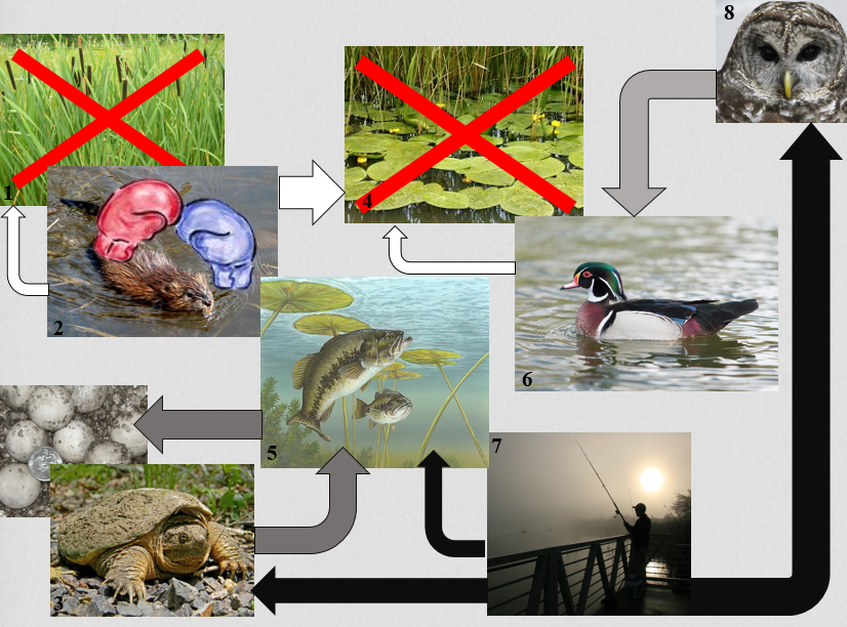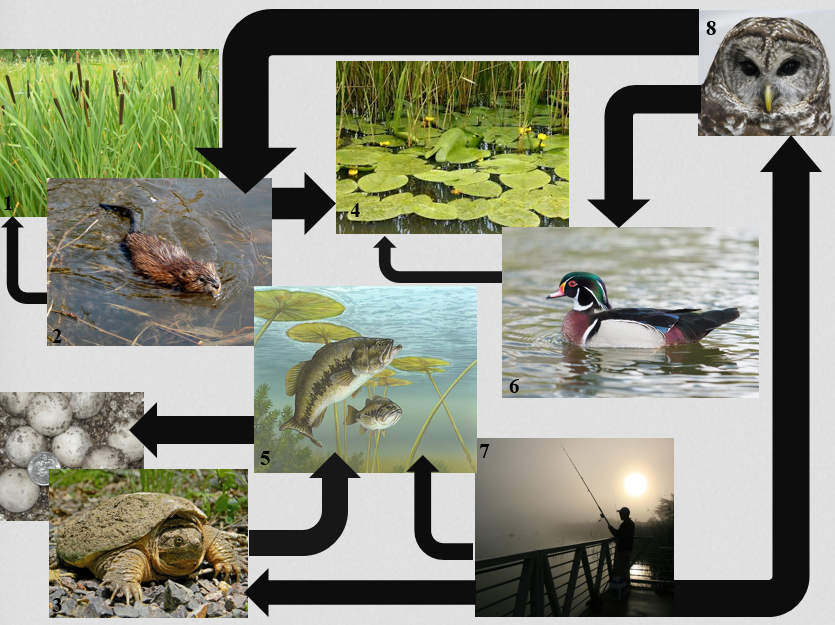Nutria on the middle river
Native species are important because of their interactions with other native species. They all contribute to the ecosystem and have stable predators and prey. Invasive species alter the food webs dramatically because they have no predators. This unfortunately allows them to compete with as well as destroy populations of other species. Below is the food web of a marsh in the middle of the Wicomico River and the changes that occur when nutria enters this ecosystem. For more information, view the food web of the middle river and the nutria and native and invasive pages.
|
How do nutria affect the ecosystem?
1. Cattails, a native species, are one of many food sources for nutria. Nutria are opportunist feeders that will eat virtually any vegetation. Because nutria consume massive amounts of vegetation, they are capable of destroying an entire marsh. This reduces biodiversity and results in erosion. 2. Muskrats are put in direct competition with nutria. Because nutria and muskrats consume the same vegetation, muskrats suffer a dramatic loss of food sources. Nutria also prefer habitats identical to muskrats. Muskrat huts are actually overtaken by nutria, giving muskrats no place to live. Additionally, the predators that eat muskrats will not eat nutria because they are slightly larger and often more aggressive. This competition severely threatens muskrat populations. 3.Eastern Snapping Turtles Because vegetation dramatically decreases with nutria presence, the biodiversity is lacking. Crayfish, toads, frogs, and small fish that turtles rely on as food become uncommon, affecting the snapping turtles ability to survive. |
4. Yellow pond Lily suffers the same way cattail does. Nutria consume this vegetation faster than any other species has, and the pond lily cannot reproduce fast enough to maintain a stable population. Decreases in biodiversity result because many of the species that relied on this no longer have adequate food sources.
5. Largemouth Bass, similarly to snapping turtles, rely on small fish. Because the small fish have no vegetation to consume they die out, removing food sources for largemouth bass. Unfortunately, nutria do not prevent their predators, humans, from fishing for them.
6. Wood Ducks are heavily affected because their food sources are completely destroyed.
7. Humans are dramatically affected by nutria. If not stopped, the massive losses in vegetation result in soil erosion and the disappearing of wetlands. As biodiversity decreases, humans lose food sources too.
8. Barred Owls consume a variety of animals but they will not eat nutria. Muskrats are a major food source for them, lost as they are forced out of their homes and lose their food sources. Barred owls continued to be threatened by humans while losing more and more of their population due to lacking food sources.
5. Largemouth Bass, similarly to snapping turtles, rely on small fish. Because the small fish have no vegetation to consume they die out, removing food sources for largemouth bass. Unfortunately, nutria do not prevent their predators, humans, from fishing for them.
6. Wood Ducks are heavily affected because their food sources are completely destroyed.
7. Humans are dramatically affected by nutria. If not stopped, the massive losses in vegetation result in soil erosion and the disappearing of wetlands. As biodiversity decreases, humans lose food sources too.
8. Barred Owls consume a variety of animals but they will not eat nutria. Muskrats are a major food source for them, lost as they are forced out of their homes and lose their food sources. Barred owls continued to be threatened by humans while losing more and more of their population due to lacking food sources.


